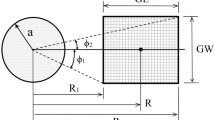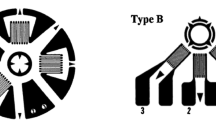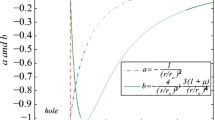Abstract
The conventional way to present Integral Method calibration data for hole-drilling residual stress measurements is in the form of a large triangular table of numbers. In the common case where 20 drilling steps are used for the hole-drilling measurement, 231 numerical coefficients are needed. While such tables are effective, their bulk inhibits their use for other than the most common experimental arrangements; the convenience and usefulness of the hole-drilling method would be much extended if the bulk of the calibration data could be reduced. Here, a two-variable polynomial formulation is proposed to represent the hole-drilling calibration data. It comprises 15 numerical coefficients and provides calibration data with average accuracy within 1%, with occasional outliers reaching around 2%. The compactness of the calibration stimulated exploration of hole-drilling response beyond the conventional “thick” specimen case, also to include finite thickness specimens down to very thin (through-hole) geometries. Tables of calibration data are provided here for ASTM E837 Type A, B and C strain gauge rosettes, for various hole diameters, for conventional “thick” specimens, and for finite thickness specimens down to the through-hole case.








Similar content being viewed by others
References
Schajer GS, Whitehead PS (2018) Hole-drilling method for measuring residual stress. Morgan & Claypool, Williston, USA
Grant PV, Lord JD, Whitehead PS (2002) The measurement of residual stresses by the incremental hole drilling technique. Measurement Good Practice Guide no.53, National Physical Laboratory, Teddington, UK
Vishay Measurements Group, Inc. (1993) Measurement of Residual Stresses by the Hole-Drilling Strain-Gage Method. Tech Note TN-503-6. Vishay Measurements Group, Inc., Raleigh, NC. 16pp
ASTM (2013) Determining residual stresses by the hole-drilling strain-gage method. Standard test method E837-13a. American Society for Testing and Materials, West Conshohocken, PA
Rendler NJ, Vigness I (1966) Hole-drilling strain-gage method of measuring residual stresses. Exp Mech 6(12):577–586
Schajer GS, Abraham C (2014) Residual stress measurements in finite-thickness materials by hole-drilling. Exp Mech 54(9):1515–1522
Held E, Schuster S, Gibmeier J (2014) Incremental hole-drilling method vs. thin components: a simple correction approach. Adv Mater Res 996:283–288
Alegre JM, Díaz A, Cuesta II, Manso JM (2019) Analysis of the influence of the thickness and the hole radius on the calibration coefficients in the hole-drilling method for the determination of non-uniform residual stresses. Exp Mech 59(1):79–94
Beghini M, Bertini L, Giri A, Santus C, Valentini E (2019) Measuring residual stress in finite thickness plates using the hole-drilling method. J Strain Anal Eng Des 54(1):65–75
Schajer GS (1991) Strain data averaging for the hole-drilling method. Exp Tech 15(2):25–28
Schajer GS (1988) Measurement of non-uniform residual stresses using the hole-drilling method. Part I J Eng Mater Technol 110(4):338–343
Schajer GS (1988) Measurement of non-uniform residual stresses using the hole-drilling method. Part II J Eng Mater Technol 110(4):344–349
Zuccarello B (1999) Optimal calculation steps for the evaluation of residual stress by the incremental hole drilling method. Exp Mech 39(2):117–124
Dahlquist G, Björk A, Anderson N (1974) Numerical methods. Prentice-Hall, Englewood Cliffs, USA
Taylor RL (2017) FEAP - a finite element analysis program. http://projectsceberkeleyedu/feap/ Accessed December 20, 2018
Wilson EL (1965) Structural analysis of axisymmetric solids. AIAA J 3(12):2269–2274
Baldi A (2017) Far-field boundary conditions for calculation of hole-drilling residual stress calibration coefficients. Exp Mech 57(4):659–664
Schajer GS (1993) Use of displacement data to calculate strain gauge response in non-uniform strain fields. Strain 29(1):9–13
Schajer GS, Prime MB (2006) Use of inverse solutions for residual stress measurements. J Eng Mater Technol 128(3):375–382
Whitehead PS (2019) Stresscraft Ltd, Shepshed, Leicestershire, UK Personal communication, October 2019
Beghini M, Bertini L, Santus C (2010) A procedure for evaluating high residual stresses using the blind hole drilling method including the effect of plasticity. J Strain Anal Eng Des 45(4):301–318
Schuster S, Steinzig M, Gibmeier J (2017) Incremental hole drilling for residual stress analysis of thin walled components with regard to plasticity effects. Exp Mech 57(9):1457–1467
Schajer GS, Altus E (1996) Stress calculation error analysis for incremental hole drilling residual stress measurements. J Eng Mater Technol 118(1):120–126
Acknowledgements
This work was financially supported by the Natural Sciences and Engineering Research Council of Canada (NSERC). Dr. Philip Whitehead kindly gave many important comments and insights. Prof. R. L. Taylor generously provided the FEAP software used for the finite element analyses reported here, and kindly added the axi-harmonic element needed for the shear stress calculations.
Author information
Authors and Affiliations
Corresponding author
Additional information
Publisher’s Note
Springer Nature remains neutral with regard to jurisdictional claims in published maps and institutional affiliations.
Appendix
Appendix
Rights and permissions
About this article
Cite this article
Schajer, G.S. Compact Calibration Data for Hole-Drilling Residual Stress Measurements in Finite-Thickness Specimens. Exp Mech 60, 665–678 (2020). https://doi.org/10.1007/s11340-020-00587-4
Received:
Accepted:
Published:
Issue Date:
DOI: https://doi.org/10.1007/s11340-020-00587-4




